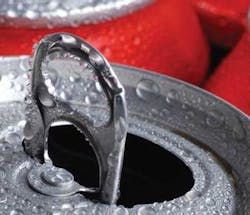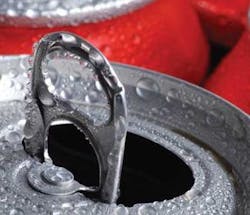What Are We Drinking?
The soft drink industry is using every ounce of creativity to bring new formulations to the marketplace, bringing to mind a “buyer beware” approach in selecting beverages. But before we can change the world, we need to examine our own personal habits.
by Anne Nugent Guignon
According to the Beverage Marketing Association, every man, woman, and child in the United States ingests 192 gallons of liquid a year. That translates to about 3.7 gallons per week or two liters per day. While this figure includes consumption of all types of beverages, it is shocking that more than 28 percent of all beverages consumed are carbonated soft drinks. Fruit beverages, sports drinks, coffee, and tea increase the intake another 19.8 percent.
If you’re having trouble visualizing the quantity of soft drinks consumed annually, consider a standard bathtub, which typically holds from 30 to 32 gallons of water. Imagine the short- and long-term effects of three tubs full of soft drinks not only on the teeth but the rest of the body. The ramifications are amazing.
Close to one-half of our liquid intake every year is of questionable nutritional value and contributes to a variety of health issues, including diabetes, obesity, caries, and osteoporosis.
Even though the consumption of carbonated beverages has been declining slightly for the past few years, the facts surrounding soda pop are still alarming. The single biggest source of calories in the American diet comes from carbonated beverages, which account for seven percent of all calories. Add noncarbonated soft drinks — which includes sports drinks, fruit-flavored drinks, teas, and coffees — and the caloric intake increases to 9 percent. Most soft drinks contain large amounts of sugar that come from an inexpensive sweetener called high-fructose corn syrup.
Fifty years ago it was a treat to drink a 6.5 ounce soda pop, which was an average serving. Within 10 years, 12-ounce canned sodas were the new standard. Today, soft drinks are a regular part of daily dietary intake. An average serving is now 20 to 24 ounces, and in many settings, soft drink portions exceed 36 ounces or more.
Coupled with the increase in size, consumption rates have increased dramatically among teenage and young adult consumers. Thirty years ago, boys aged 12 to 19 years consumed twice as much milk as soft drinks, and girls of the same age consumed one-and-a-half times more milk as other beverages. Today’s teens drink twice as much soda pop as milk.
Teens and young adults are consuming ever-increasing amounts of empty-calorie beverages. Along with increased caloric intake, soft drinks usually do not contain vitamins, minerals, or dietary fiber. Empty-calorie drinks have replaced nutrient-dense beverages. Researchers believe this dietary shift is a major factor in rising numbers of overweight and obese teens. Current research indicates that at least 65 percent of all teens fall into either the overweight or the obese category. Once viewed as primarily an adult condition directly correlated to weight gain, the incidence of Type II diabetes has skyrocketed in the teenage and young adult population, especially among females.
In addition, excess weight gain has a significant impact on cardiovascular health and cancer rates. Studies also suggest that frequent consumption of soft drinks may lead to an increased incidence of bone fractures among young adults or the development of osteoporosis in later life, especially when dietary intake of calcium is reduced in favor of empty calorie soft drinks. Bone mass is built in early life. Women reach more than 90 percent of their bone density by their late teens.
With the decreased consumption of milk over the last three decades and the increased intake of soft drinks, calcium intake among today’s girls is well below recommended rates, creating significant concern about increasing rates of bone fractures among young adults. While exact rates vary per study, there appears to be a definite increase in fractures.
There are conflicting studies regarding phosphoric acid found in colas and other soft drinks. Some researchers believe that calcium is leached out of bones to balance the increase in blood levels of phosphorous. Other studies do not support this finding.
High-sugar diets are also considered to contribute to heart disease. When adults at risk consume a diet high in carbohydrates, triglycerides and insulin levels rise. Studies associate high levels of triglycerides with an increased risk for cardiovascular disease and diabetes.
Researchers have also looked at the role of coffee, tea, and colas in the formation of kidney stones, a painful disorder that affects 10 percent of all Americans sometime in their lives. Young men are the heaviest consumers of soft drinks, and men are much more likely to suffer from this painful disorder than women.
Manufacturers add caffeine, a mildly addictive stimulant, to the majority of dark-colored sodas as well as some lighter colored varieties, claiming that caffeine adds flavor. Research indicates that consuming two to three cans of soda pop results in ingesting 100 mg of caffeine per day, which can lead to physical dependence on this additive. New soft drink products are being introduced that contain two to three times the level of caffeine found in traditional soda pop.
Artificial colors, sweeteners, and preservatives have also come under attack for causing allergic reactions, being responsible for attention-deficit hyperactivity disorder (ADHD) in sensitive individuals or producing carcinogenic compounds.
Dental professionals are particularly concerned about soft drinks for two reasons: pH and sugar content. Carbonated soft drinks contain various amounts of phosphoric, citric, and carbonic acid. The pH of most soft drinks falls between 2.3 and 3.4, ranges that can be responsible for significant tooth demineralization. This includes carbonated and noncarbonated beverages, as well as those that contain sugar and those classified as sugar-free. A 12-ounce serving of soda pop contains from 9.6 and 11 teaspoons of sugar in a highly fermentable form, which leads to further acid production by oral bacteria.
Soft drink manufacturers spend millions of dollars every year marketing their products via print, television, billboards, and radio. Soft drinks of all types are readily available from vending machines, fast food restaurants, convenience stores, and school-based programs. Grocery stores run weekly specials on soft drinks. Soft drinks are inexpensive! Cash-strapped families can purchase a two-liter bottle of soda, which is 2.1 quarts, for 59 cents. A half-gallon of milk runs $2.19, which is four times the cost of an equivalent amount of soda pop.
Sales of high-sugar soft drinks have slipped. Diet sodas and bottled water consumption are on the increase. Adding nutrients to carbonated beverages is the newest wrinkle in the ongoing beverage wars. New products include beverages with large amounts of caffeine, ginseng additives, and so called “fortified beverages” that contain vitamins B3, B6, and E, and chromium or niacin, vitamins B6 and B12, magnesium, and zinc. Clearly, the soft drink industry is using every ounce of creativity to bring new formulations to the marketplace, bringing to mind a “buyer beware” approach in selecting beverages.
Before we can change the world, we need to examine our own personal habits. What are we drinking? What are we serving in our own homes or at our professional functions? Are soft drinks part of our personal comfort zone? The Missouri Dental Association Web site, modental.org, is an excellent resource for practical information. Arm yourself with the facts and then spread the word about the real effects of soft drinks.
About the Author
Anne Nugent Guignon, RDH, MPH, is the senior consulting editor for RDH magazine. She is an international speaker who has published numerous articles and authored several textbook chapters. Her popular programs include ergonomics, patient comfort, burnout, and advanced diagnostics and therapeutics. Recipient of the 2004 Mentor of the Year Award, Anne is an ADHA member and has practiced clinical dental hygiene in Houston since 1971. You can reach her at [email protected] or (713) 974-4540, and her Web site is www.anneguignon.com.
Total U.S. Beverage Consumption in 2005
- Carbonated Soft Drinks 28.3%
- Bottled Water 10.7%
- Milk 10.9%
- Coffee 9.0%
- Beer 11.7%
- Fruit Beverages 4.7% *
- Sports Drinks 2.3%
- Tea 3.8%
- Wine 1.2%
- Distilled Spirits 0.7%
- All Others 15.3% **
* Includes fruit beverages and fruit drinks; excludes powdered fruit drinks and vegetable juices.
** Includes tap water, vegetable juice, powders, and miscellaneous drinks.
SOURCE: Beverage Marketing Corporation
Average Ingredients in a 12-Ounce Can of Soda Pop
- 10 teaspoons of sugar
- 150 calories
- 30 to 55 mg of caffeine
- Artificial food colors / flavors
- Phosphoric acid or citric acid
- Aspartame — sugar-free drinks

